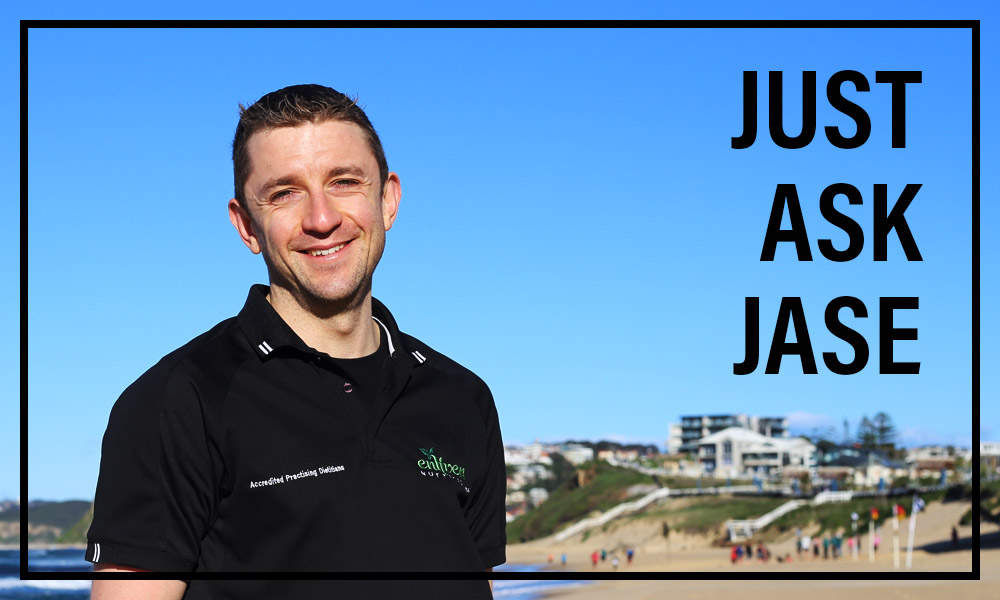
Hi Jase,
Salt gets a bad wrap most of the time I see it talked about, however there have been a few articles I’ve read lately that said that muscle cramps are due to a lack of sodium. If low sodium causes cramps, why do people think salt is so bad for your health?
– SavoryTaste

Thank you for your question!
Salt is something that is often overlooked within the diet, fading into the background aura of the main macronutrients of carbohydrates, proteins and fats. We always have heard the messages to watch our salt (or sodium) intake in our diet, but we have not really been given a solid understanding of why. Why is salt added to so many foods, what can it do for our food and what effects can it have within our body?
When for general health we only need 1600mg of sodium (salt) each day, with an upper limit of 2400mg sodium (salt) each day. And if you are struggling to work out how to convert sodium to salt, use this equation:
Sodium grams x 2.5 = salt in grams
So let’s look at why salt is being added to so many foods and what it does to foods. It really comes down to three main areas:
- Taste: Additional salt added to foods acts as a flavour enhancing agent, and can even enhance other attributes such as the sweetness of a food (think salted caramel). With the ever-expanding industry of processed convenience foods where taste is often the determinant of consumer choice, the addition of significant amounts of salt (or sodium) is commonplace and can be the difference between a products success or failure in the marketplace.
Another key area to note, is the tolerance that is built to salt or sodium within our diet. Simply put, the constant intake of high salt/sodium foods will lead to other lower sodium foods tasting bland, with the opposite true for those reducing salt in their diet as the body becomes far more “sensitive” to tasting the salt/sodium in lower concentrations.
- Preservation: A cheap and easy way to ensure microbes do not spoil your food is to add a bucket-load of salt to it. Think back to when Captain Cook was around, just about everything on the ship was pickled and high in salt to ensure that the foods had a longer lifespan. Another key point is that salt is dirt-cheap. Food companies know this, and also know the appeal of a longer shelf-life for their products which is another key reason that pre-packaged foods and preserved foods are quite high in salt/sodium. Salt is a fantastic agent to inhibit bacterial growth, they simply cannot stand the salty environment and prosper as in other areas.
- Texture Modification: Adding salt to a food acts to draw moisture content. Again think of the best pork crackling you have ever had, or the crispiest skinned salmon you have ever had. Salt was used in those instances to draw out the moisture content and provide that textural effect.
So now we understand why salt is found in heavy concentrations in pre-packaged foods and even the take-away foods you consume. But what effect does it have on the body? Essentially the risk you run with a high salt intake is developing high blood pressure, which is bad news for your organs. Higher pressure in your circulation system is akin to having high pressure in the radiator of your car, over time the risks of something going “pop” and breaking down significantly increases. For your body, this “pop” could mean a heart attack, heart failure, stroke or kidney damage with some of the lesser known consequences being oedema, heart muscle thickening or osteoporosis.
Some great additional reading regarding your sodium/salt requirements and the topic in general can be found here, here, and here
Essentially, lowering your sodium intake in today’s world can be difficult, especially considering some food staples in Western diets that are minimally processed (such as dairy products) are quite high in sodium, along with most bread products. Although it has not been proven a certainty that a high sodium intake will cause high blood pressure development and the associated health risk factors listed above, it is always wise to use the analogy of less is more with salt.
If in doubt, opt to eat a diet full of foods that aren’t processed or contain minimal processing and refrain from adding extra salt to your foods at the table and in cooking and you are well on the way to addressing this common nutrition concern. If you would like further information on how to tweak your nutrition to lower your sodium intake, be sure to contact our experienced team at Enliven Nutrition today!
— Jase
Got a nutrition or training question? Or just want to know how to become better than yesterday?










